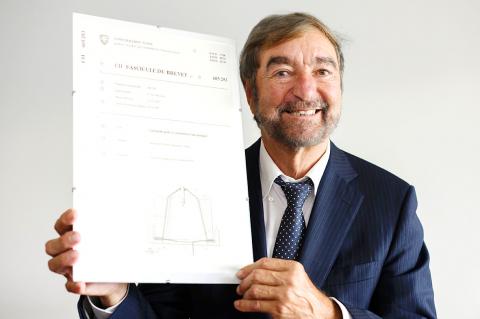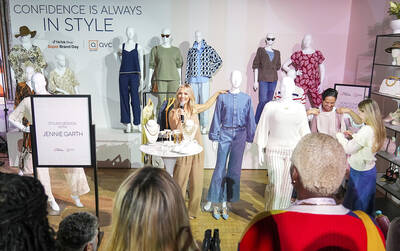Had Eric Favre not married an Italian woman, it is possible none of us would be drinking Nespresso.
The man who conceived of single-portion coffee capsules four decades ago said he was always destined to be an inventor, but some teasing by his wife, Anna Maria, steered him toward the idea that revolutionized home coffee consumption.
A trained rocket engineer, Favre said he joined Nestle’s packaging department in 1975 to learn the inner workings of a multinational corporation before branching out on his own.

Photo: AFP
That is when Anna-Maria told her Swiss husband that his country knew nothing about making coffee.
“I wanted to prove to my new wife that I have the capacity to make the best espresso,” Favre, 69, said during a tour of his office in Saint Barthelemy, Switzerland, which includes a small museum devoted to his iconic invention.
In the coming months he scoured Rome in search of the perfect brew and developed a prototype espresso machine that looked like an unused prop from one of the Back to the Future films — an awkward assembly of cylinders and tubes.
Resistance within Nestle against home-made espresso was stiff.
Nescafe, its enormously popular instant coffee blend, was enjoying its initial boom and company executives saw little need to invest in expensive home espresso machines, certain the instant mix would remain home consumers’ preferred brew.
Favre persisted and Nespresso was finally launched in 1986, with Favre as its director-general.
Thirty years on, the counter-top machine is a key revenue generator for Nestle, the world’s largest food and beverage company. It no longer gives breakout statistics for Nespresso, but the Bloomberg news agency estimated sales at US$4.5 billion last year.
Yet challenges are mounting as competitors cut into Nespresso’s market share and environmental concerns have risen about the waste generated by used pods.
Favre left Nestle long before Nespresso became a massive global brand with a movie-star pitchman, but voiced hope that the coffee pod’s creation story would not be lost.
“It’s not just about pictures of George Clooney,” he said, referring to Nespresso’s brand ambassador.
In 1975, Favre’s coffee quest took him to the Caffe Sant’Eustachio, now listed in travel guides as a place serving one of the best espressos in Rome, but which at the time stood out because it was busier than everywhere else.
Using Anna-Maria as his “spy,” Favre said he discovered that a key to Sant’Eustachio’s superior coffee and crema was repeated aeration while hot water was being pumped through the coffee grinds.
His idea for a machine that aimed for maximum aeration through a carefully formulated single-portion pod was born while watching Sant’Eustachio’s barrista, Favre explained.
In 1983, Nestle sent Favre on assignment to the Nescafe factory in Japan.
He decided to pitch Nespresso’s merits to the chief executive there, hoping for better luck than he had with his bosses in Switzerland.
The plan worked and Nespresso launched in 1986, but it suffered initial stumbles and Favre left Nestle in 1991.
He went on to found a string of successful coffee pod companies, including Monodor, which developed more energy-efficient pods that had more coffee and generated less waste from packaging.
Nespresso’s popularity, meanwhile, exploded, but several of its key patents expired in 2011, which represents “a major threat” to its growth, said Virginia Lee, senior beverage analyst at market research firm Euromonitor International.
Competitors, including companies that make Nespresso compatible pods, “are growing rapidly and cannibalizing Nespresso’s share of coffee pods due to lower prices and wider distribution,” Lee wrote in a report last year.
In Western Europe, for example, Nestle’s coffee pod market share fell from 41 percent in 2011 to 37 percent last year, according to Euromonitor.
Favre predicted this five years ago, telling the Global Coffee Review magazine in 2011 that Nestle would face threats from new capsule makers flooding the market and that to stay ahead, the company would have to maintain a rigorous focus on quality.
And despite leaving the company a quarter-century ago under somewhat acrimonious circumstances, Favre is still willing to help.
Moving through his homemade exhibit that details the evolution of his capsule from clunky prototype to the widely sold version shaped like a miniature bucket, the businessman seemed proud that Nespresso’s chief executive Jean-Marc Duvoisin made the trip to Saint Barthelemy two months ago.
Asked why a top Nespresso boss would visit him, Favre said: “To learn this story.”

BYPASSING CHINA TARIFFS: In the first five months of this year, Foxconn sent US$4.4bn of iPhones to the US from India, compared with US$3.7bn in the whole of last year Nearly all the iPhones exported by Foxconn Technology Group (富士康科技集團) from India went to the US between March and last month, customs data showed, far above last year’s average of 50 percent and a clear sign of Apple Inc’s efforts to bypass high US tariffs imposed on China. The numbers, being reported by Reuters for the first time, show that Apple has realigned its India exports to almost exclusively serve the US market, when previously the devices were more widely distributed to nations including the Netherlands and the Czech Republic. During March to last month, Foxconn, known as Hon Hai Precision Industry

Taiwan Semiconductor Manufacturing Co (TSMC, 台積電) and the University of Tokyo (UTokyo) yesterday announced the launch of the TSMC-UTokyo Lab to promote advanced semiconductor research, education and talent development. The lab is TSMC’s first laboratory collaboration with a university outside Taiwan, the company said in a statement. The lab would leverage “the extensive knowledge, experience, and creativity” of both institutions, the company said. It is located in the Asano Section of UTokyo’s Hongo, Tokyo, campus and would be managed by UTokyo faculty, guided by directors from UTokyo and TSMC, the company said. TSMC began working with UTokyo in 2019, resulting in 21 research projects,

Ashton Hall’s morning routine involves dunking his head in iced Saratoga Spring Water. For the company that sells the bottled water — Hall’s brand of choice for drinking, brushing his teeth and submerging himself — that is fantastic news. “We’re so thankful to this incredible fitness influencer called Ashton Hall,” Saratoga owner Primo Brands Corp’s CEO Robbert Rietbroek said on an earnings call after Hall’s morning routine video went viral. “He really helped put our brand on the map.” Primo Brands, which was not affiliated with Hall when he made his video, is among the increasing number of companies benefiting from influencer

Quanta Computer Inc (廣達) chairman Barry Lam (林百里) yesterday expressed a downbeat view about the prospects of humanoid robots, given high manufacturing costs and a lack of target customers. Despite rising demand and high expectations for humanoid robots, high research-and-development costs and uncertain profitability remain major concerns, Lam told reporters following the company’s annual shareholders’ meeting in Taoyuan. “Since it seems a bit unworthy to use such high-cost robots to do household chores, I believe robots designed for specific purposes would be more valuable and present a better business opportunity,” Lam said Instead of investing in humanoid robots, Quanta has opted to invest